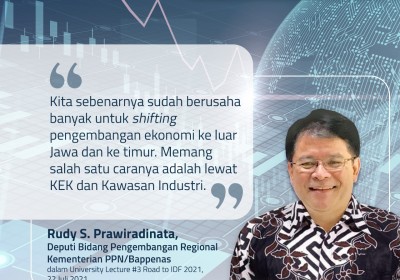Development of Special Industrial Zones Requires Collaboration of All Relevant Stakeholders
August 02, 2021
JAKARTA – The development of new industrial zones and new cities are key towards fulfilling further economic growth.
President Joko Widodo has stated that Indonesia must begin to push for equal economic distribution across all regions, since the Indonesian economy has remained Java-centric in the past 30-40 years, with Java and Sumatra contributing 80% of the country's total economic output.
"We've begun efforts to shift economic activities outside of Java and to the Eastern regions of Indonesia. One of the most effective ways to do so is to build industrial estates (KI) and special industrial zones (KEK) in these areas," the Ministry of National Development Planning/Bappenas' deputy for regional development Rudy S. Prawiradinata mentioned during the University Lecture #3 Road to Indonesia Development Forum 2021 webinar on Thursday (22/7).
The construction of strategic economic zones are one of the main priorities of the government's 2020-2024 Mid-Term Working Plan (RPJMN), which aims to improve economic competitiveness in various regions through the construction and/or implementation of special economic zones (KEK), industrial estates (KI), free trade and free port zones (KPBPB), and priority tourism destinations (DPP).
To make it happen, the government plans to implement several strategies which include strengthening production bases and processing leading regional commodities, building smelters, providing integrated infrastructure networks, licensing and investment services, strengthening connectivity with raw material producers, developing financing partnerships between government and business entities, strengthening cooperation between other stakeholders and expanding partnership opportunities.
Rudy added that the construction of new cities can be used as a strategy to drive economic growth in the future. Studies conducted by the World Bank and Bappenas show that urbanization can help grow the economy per capita if the urban facilities are of good quality.
In the Indochina region, for example, it was observed that an urban growth of 1% was able to contribute up to 3-4% in economic growth per capita. In Indonesia, however, a 1% urban growth only resulted in a growth of 1.3%.
"This means that the facilities in our cities are not good enough. Upgrading urban facilities should be one of the government's next priorities after constructing KEKs and KIs, as both are able to contribute greatly to economic growth," Rudy explained.
"By 2045, it is projected that 60-70% of a country's population will be in the cities. That is why there is so much potential in this area," he added.
The aim of developing KEKs is to stimulate economic activity in regions outside of Java. By doing so, the government believes that it will help develop the region, create more jobs, attract more investment and optimize industrial activity. "The government's role in this is to help provide the soft and hard infrastructures needed to make the development possible, mainly fiscal and non-fiscal facilities," Rudy said.
Fiscal incentives will be given to zones that are able to engage in exporting and importing, and will also provide a large multiplier effect that can guarantee a KEK's contribution to national economic growth.
For underdeveloped regions, the infrastructure development of areas such as integrated fishery centers (SKPT), national village development centers (KPPN), strategic district areas (KSK) and strategic tourism areas (KSPN) can be prioritized first to help boost the local and regional economy.
Indonesia currently has 18 KEKs. Plans to establish four new KEKs were revealed in 2021, which include the KEK Nongsa, KEK Batam Aero Technic, KEK Lido and KEK Gresik. As of Q1 2021, the cumulative investment value of 14 KEKs reached Rp 52.23 trillion, with 22,986 new jobs created.
Indonesia’s Research Institutions Supporting the Development of the Electric Vehicle Industry
Indonesian Muslim Fashion and Cosmetics IKMs Shine at Dubai World Expo 2020
Govt Steps Up UMKM Transformation Efforts in the Midst of Pandemic Slowdown
Govt Encourages Promotion of IKM Products in Digital Era
Government Begins Developing Maritime Training Center in Makassar
Tweets by IDDevForum
